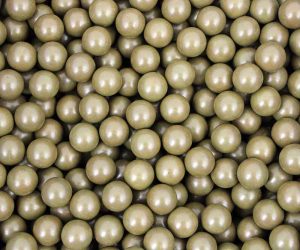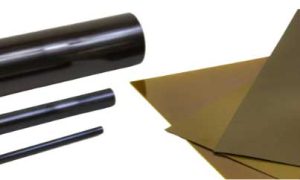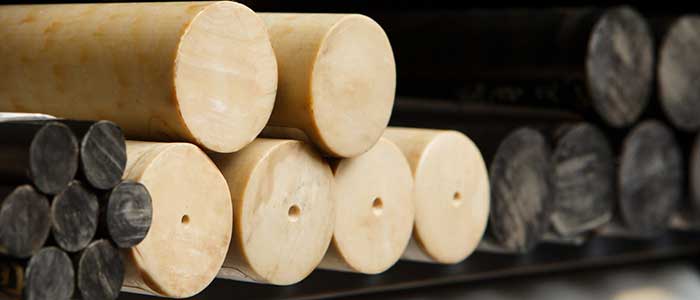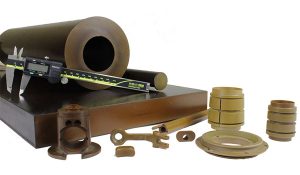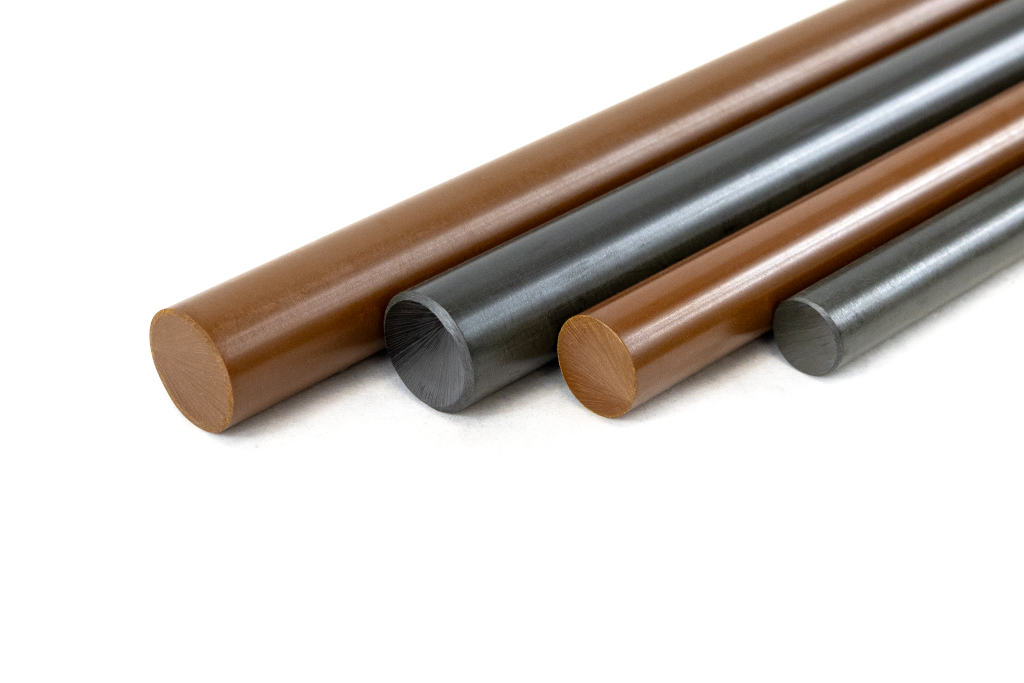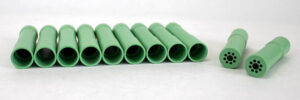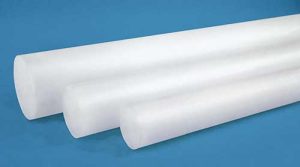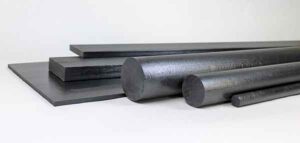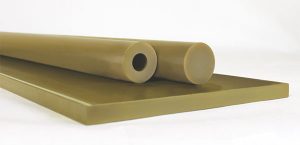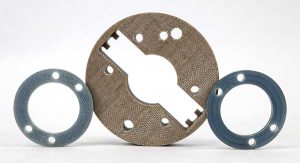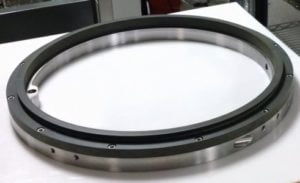PEEK is a workhorse – perhaps the closest to a perfect material that is utilized in a wide range of industries and in a variety of applications. It is known for its impressive durability in punishing environments. Glass and carbon reinforced grades are among the strongest of all thermoplastics at room temperature and unfilled grades are highly resistant to some of the most chemically aggressive environments including high-pressure steam.
First introduced by Victrex PLC, then ICI (Imperial Chemical Industries) in the early 1980s it has been gaining use for nearly 40 years. Others including Solvay entered PEEK resin production in the early 2000s after Victrex PLC’s patent rights expired so today end users and specifiers have no shortage of PEEK resin grades from which to choose. Name recognition still favors the Victrex brands but others led by Solvay’s Ketaspire PEEK are gaining both volume and market share each year. Today Solvay is the only US-based producer of PEEK resin.
Why PEEK?
PEEK is short for polyether ether ketone, which doesn’t make sense to many other than those with a strong chemistry background. Put simply, it refers to the chemical structure of the polymer although most polymer scientists identify PEEK as being part of the broader family of ketone polymers called polyarylether ketones (PAEKs). This PAEK family covers a number of different compositions with different ratios of ether groups to ketone groups, the most common of which is PEEK. Regardless of the specific chemistry it is the polyketone chemical structure that makes PEEK so formidable in so many environments. What is it about PEEK that makes it a natural fit for so many engineering applications?
Victrex PEEK
30% carbon-fiber-reinforced grade
With 30% carbon fiber reinforcement in its formulation, Victrex PEEK 450 CA30 achieves the highest mechanical strength and stiffness available among PEEK grades. PEEK 450 CA30 is impervious to repeated autoclave cycles and resists a wide range of chemicals. It is also FDA compliant for direct food contact applications and meets the aerospace industry’s stringent flammability and low smoke requirements including UL 94 V-0.
20% PTFE – enhanced grade
Its 20% uniformly dispersed PTFE powder content gives Victrex PEEK 450 FE20 exceptional bearing and wear properties. It has a 50% lower coefficient of friction and a 25% lower wear rate than unfilled PEEK, key factors behind its use for intermittent service bushings and rotors. The 450 FE 20 grade is FDA compliant, and Its composition enables sealing at lower pressures than unfilled and reinforced grades.
10-10-10 bearing grade
Formulated with 10% graphite, 10% carbon fiber and 10% PTFE powder, Victrex PEEK 450FC30 has the lowest wear and highest PV among polyketone polymers. Specified for bushings and bearings ranging from reusable medical devices to helicopter parts, the advanced thermoplastic is not affected by repeated autoclaving. It is FDA compliant for direct food contact components, and also meets the aerospace industry’s requirements on flammability and smoke generation.
High-temperature PEK-based grade
Chemically a polyetherketone (PEK) polymer, Victrex HT has a higher glass-transition temperature (Tg) and greater creep resistance than traditional PEEK. It also exhibits higher tensile strength and flexural modulus and retains its strength at 30°C (54°F) higher temperatures. While it lacks the broader chemical resistance and fatigue properties of a true PEEK, Victrex PEK HT can be an option for many higher temperature downhole applications.
KetaSpire PEEK
Although they both meet the same Mil-P46183 standard, Solvay’s KT-820 series PEEK resins have a higher molecular weight (MW) than the Victrex 450 series. Higher MW typically equates to greater toughness and a corresponding reduction in modulus. In melt processing, the KT-820 resins’ higher MW also enables Drake to produce thicker cross sections. As options to the KT-820 series, Victrex offers higher MW resins with its 650 grades, and Solvay offers an even higher MW resin. Drake offers both these higher MW options on a made-to-order basis.
Unfilled PEEK grade
This unfilled grade has PEEK’s inherent balance of chemical, wear and temperature resistance. While fiber-reinforced and bearing grades are modified for use in higher strength and wear resistant components, unfilled PEEK also performs in these areas depending on application requirements. KetaSpire KT820NT is NORSOK M-710 certified for downhole sour gas and steam service and meets aerospace flammability and smoke generation requirements.
30% glass fiber-reinforced grade
With 30% glass-fiber reinforcement, KT 820GF30 PEEK provides a significant step up in strength and stiffness over non-reinforced PEEK grades. The glass fiber content also boosts structural performance in applications where service temperatures can far exceed PEEK’s Tg of 150C/ 302F with proper design and containment. KT820GF30 PEEK is NORSOK M-710 certified for sour gas and steam service and meets the flammability and smoke generation requirements for aircraft.
30% carbon fiber-reinforced grade
The 30% carbon fiber reinforcement in KetaSpire KT 820CF30 results in the highest strength and stiffness levels available among PEEK grades. This advanced thermoplastic withstands repeated autoclaving in reusable medical devices, and its chemical resistance has led to applications in semiconductor wet processing. KT820CF30 is NORSOK M-710 certified for downhole sour gas and steam service and meets aerospace flammability and low smoke generation requirements.
High-Temperature PEEK grade
High-temperature KetaSpire PEEK XT couples the inherent performance attributes of PEEK with a 36°F (20°C) higher glass transition temperature (Tg). Its Tg also exceeds that of Victrex HT PEK by 18°F (10°C). Because it has the same ether-to-ketone ratio of a true PEEK polymer, high-temperature KetaSpire XT has the same superior chemical and fatigue resistance that PEEK offers over PEK, PAEK and other polyketones.
PEEK Industrial Grades
Drake offers Industrial Grade PEEK stock shapes for applications that do not require certifications to Mil-P 46183 and other specifications. Priced lower than our premium quality grades, Drake Industrial Grade PEEK products are positioned to compete with other commercial PEEK stock shapes that are injection molded, extruded or compression molded. All Drake Industrial Grade PEEK shapes are supplied with a Drake Certification that confirms the resin composition and specific gravity range, but Resin Manufacturers’ Certifications are not provided. Certification example
For applications requiring Mil-P 46183, ASTM D6262 and other certifications, Drake’s stock shapes made from KetaSpire and Victrex PEEK resins are available in a wide range of popular grades and sizes. Sample certifications for these products: Victrex product cert; Solvay KetaSpire product cert
Drake’s unreinforced Industrial Grade PEEK has physical properties and chemical resistance comparable to commercially available unfilled PEEK. It is easily machinable and resists long term exposure to steam and hot water.
Drake’s Industrial Grade of bearing and wear-enhanced PEEK has a higher PV and lower wear rate than unfilled PEEK. Its strength, temperature, and chemical resistance are comparable to unfilled PEEK. It is also easily machined into precision parts. This Industrial Grade contains 10% of each graphite, carbon fiber and PTFE, similar to Ketron HPV shapes and Victrex 450FC30 and KetaSpire KT-820 SL30 bearing and wear grade resins.
With 30% glass fiber reinforcement, Drake’s GF30 industrial Grade has higher mechanical strength than unfilled and bearing grade PEEK. Combining the high strength and the inherent chemical resistance of both PEEK and glass, Drake Industrial Grade GF30 PEEK shapes are often used for machined insulators and oil and gas applications requiring chemical resistance and strength at high temperatures.
A 30% carbon fiber content gives this formulation the highest level of mechanical strength among Drake’s Industrial Grade PEEK stock shapes. It has PEEK’s wear and high temperature resistance, and withstands long term exposure to steam, hot water and a wide range of chemicals. It also performs well as a bearing material when running against hard mating surfaces. Precision machined parts can be made from stock shapes available in this grade.
More On Why Peek
- Excellent thermal properties – Unfilled PEEK offers high strength and excellent resistance to high temperatures, and will not melt until it reaches about 650 degrees Fahrenheit. It is useful at temperatures up to nearly 500 degrees Fahrenheit long term and far higher short term, which is well beyond what most polymers are capable of. PEEK’s glass transition temperature or softening temperatures is close to 300 degrees Fahrenheit. This inherent characteristic can be compensated for through reinforcements and chemistry modifications.
- Formidable chemical resistance – Unfilled PEEK offers broad chemical resistance that approaches that of PTFE but with far greater strength, which is why it is a favorite choice for chemical processing and oil and gas companies. Some of the chemicals it can withstand include most acids (the only exceptions are hydrofluoric and hydrobromic), acetone, all alcohols, ammonia, benzene, chlorine, ethylene oxide, formaldehyde, gasoline and most fuels, glycerin, hydrogen peroxide, hydrogen sulfide, methane, MEK, methylene chloride, ozone, pentane, sodium carbonate, sodium hydroxide and Toluene. And that’s just a fraction of the substances PEEK is resistant to. This broad resistance is a primary reason why PEEK is so ubiquitous, as it can be adapted for nearly any application.
- Superior wear resistance – Few polymers can match PEEK in terms of well-rounded wear resistance. Of course, “wear” is a general term, and requires further explanation.
Abrasive wear refers to cutting action caused by the countersurface’s irregularities. Fatigue wear refers to material deformation resulting from repeated pressure and stress. Friction is the resisting force against motion, and though it isn’t “wear,” it is problematic nonetheless. PEEK’s properties provide resistance to abrasive and fatigue wear, and it is a naturally low friction material. PEEK that is alloyed with PTFE graphite and carbon fiber provides low wear rates at high pressure-velocity conditions in even abrasive environments. Unfilled PEEK provides superior fatigue resistance and good wear resistance as well, provided the maximum stress and velocity are low. Twenty percent (20%) PTFE filled PEEK (FE20) offers a lower coefficient of friction and improved wear rates over unfilled PEEK. - Great processability – PEEK’s ease of processing has contributed to its wide acceptance in high volume commercial applications. PEEK components are injection molding in high volume tooling equipped with hot runner systems, machined from both extruded and injection molded stock shapes and even stamped and machined from thin strip stock or film. Machining high performance thermoplastics can be a challenge because the availability of the needed shape is often limited meaning the manufacturing cost increases due to unnecessary machining swarf and the time to create it. PEEK’s high molecular weight and melt stability enables it to be extruded into large cross sections such as rods greater than 200mm, plate up to 4” and tubes with 2” thick walls. There are more than 50 different sizes of PEEK rod and plate stocked and ready for immediate shipment. Additionally PEEK is one of the few high performance thermoplastics that can tolerate the kind of extensive machining needed to produce components with complex geometries one of reasons why it is found in so many diverse applications.
- Biocompatibility – The medical industry is always in search of materials that can be utilized in the human body. Many polymers are rejected by the body’s immune system, resulting in serious, even life-threatening complications. And even when the material is accepted, it may wear down due to abrasive wear and intense friction, causing pieces of the material to splinter off and interfere with biological function. PEEK’s high strength and modulus that approximates human bone already been used in many procedures, including spinal implants and skull reconstruction. PEEK is inert and biocompatible and is considered a leading candidate for surfaces and parts that direct contact bio fluids whether during chemical analysis or surgical procedures.
Machining or Injection Molding… You choose how to make it
Because PEEK can either be injection molded or machined into components, some insight into both processes bears mentioning. To be clear upfront, neither process is clearly superior in all instances. Process selection is something project engineers will need to study closely, and something that should be discussed with component suppliers.
During injection molding, the PEEK is injection molded into a custom cavity that is part of a complex tool generally costing more than $10,000. This is the most efficient and fastest route to making parts provided the tooling investment is justified. Machining, on the other hand, uses stock shapes and machine shops that mirror the route most metal parts are produced. A bar of PEEK rod can generally be machined into bushings or bearings often within a few days for hundreds of dollars meaning speed and flexibility are unmatched. The properties of extruded shapes offer the highest stiffness and greatest toughness and in general the most reliable performance.
Machining PEEK is the preferred option in most high precision applications. This includes when production runs involve lower volumes (especially runs under 5,000 parts), when larger components need to be produced and when toughness and impact strength are major priorities. In short, machining works best when the components need to offer excellent mechanical and wear properties.
Again, there is no clear winner between the two processes but there are situations where one offers a major advantage. Injection molding PEEK is the better choice when producing complex parts (usually more than 10,000 during a single run), as injection molding eliminates machining time and waste resulting in the lowest possible unit costs. Injection molding is also the appropriate choice when machining presents difficult to overcome geometric challenges.
Where PEEK is Used?
Unfilled PEEK dominates the volume of PEEK consumed worldwide. Its durability, availability and processability make PEEK the material of choice when high strength and inertness especially at elevated temperature a fit in many industries. New uses are being devised for the polymer all the time. Some of the polymer’s prominent uses include:
- Semiconductors and electronics – PEEK’s ability to retain its strength at high temperatures, its purity as well as its ability to withstand harsh chemicals makes it a natural fit for semiconductor and electronics manufacturing. PEEK can be machined into wafer handling tools and hardware, which is especially useful during chemical washing. Unfilled PEEK is also critical during chip production, particularly during chemical mechanical planarization and etching. One of the largest volume applications for PEEK film is in cellular phones
- Oil and Gas – In the oil and gas industry, unfilled PEEK and glass-filled PEEK are typically processed into seals and electrical connectors, where they serves as insulators and isolators as well as reinforcements for softer seal materials. PEEK is a strong choice for oil and gas applications as it is highly resistant to steam and the kinds of chemicals encountered in aggressive downhole environments. PEEK valve seats and seals down stream help manage the flow of petrochemical gases and liquids without risk of chemical degradation
- Aerospace – PEEK is utilized in both commercial and military aircraft, and in both settings, only reliable, durable materials are utilized. In the aerospace industry, it is PEEK’s low smoke generation and excellent thermal resistance that prove valuable as unfilled PEEK is so resistant to heat and fire that it self-extinguishes. These properties make it a good fit for aerospace electronics, which tend to be highly stressed, and thermal isolators, which must handle both high heat and very cold conditions. Carbon fiber reinforced PEEK grades like 450CA30 and KT820CF30 provide the maximum strength and stiffness without the high density of glass reinforced PEEK grades.
- Medical – Unfilled PEEK’s biocompatibility has already been addressed, and it is this property that has unfilled PEEK acting as implants, including spinal and dental implants. Even carbon fiber reinforced PEEK remains inert and stable for long periods of time, to the point where implants outlive patients. PEEK’s inertness and stability mean it can withstand repeated autoclaving allowing it to function in reusable medical instruments. Also valuable is PEEK’s radiolucency. In other words, PEEK remains invisible to radio imaging, which includes CT and MRI scanning, as well as X-ray imaging. This radiolucency is especially important for studying tissue growth processes, as the implant will not screen surrounding tissues from view.
- Food and packaging – Unfilled PEEK comes in food-grade varieties, so it can be integrated into appliances and surfaces that come in contact with food. Standard applications include filling nozzles, mixing paddles, bearings, bushings and valve components especially those involved in citrus fruit processing and hot filling machines. Valve bodies have migrated from acetal to unfilled PEEK as process temperatures have increased. Additionally, unfilled PEEK is impervious to all clean in place (CIP) solutions.
The above is only scratching the surface for PEEK applications. As companies reach for greater and greater “in use” cost-effectiveness, they often turn to PEEK to get there. PEEK is the most available and versatile high performance polymers on the market today.
What types of PEEK are available?
Unfilled PEEK offers unmatched chemical Inertness, FDA compliance and strength up to 300°F. Its superior machinability and cleanliness make it ideal among all ketone based polymers for tightly toleranced complex machined parts or injection molded parts such gears, ferrules and life science and medical parts. See more on KT820NT Comprehensive Overview
Carbon Fiber Reinforced PEEK offers the highest strength and stiffness among the PEEK grades. It is 7% lighter than glass reinforced grades despite containing more reinforcement per unit volume. It is an excellent choice for highly load machined or molded parts. See more on 450CA30 or KT820CF30 Comprehensive Overviews.
Glass Fiber Reinforced PEEK offers the higher strength and stiffness than unfilled PEEK grades but with excellent electrical and thermal insulation characteristics. It is an excellent choice for highly load machined or molded parts including back up seals and electrical connector bodies. See More on KT820GF30 Comprehensive Overview
Bearing Grade PEEK offers the lowest wear rates among the PEEK grades for demanding wear applications. The most common grades contain a combination of graphite, PTFE and carbon fiber with the most common ration being 10-10-10 blend. This combination promotes low friction and higher conductivity enabling for higher PVs and lower wear rates. See 450FC30 or KT820SL30 or 450FE20 Filled Peek Comprehensive Overviews
High-Temperature PEEK or PEK is a slightly different chemistry and is based on polyether ketone PEK rather than PEEK. PEK and PEKEKK offer higher softening temperatures than traditional PEEK chemistries. The improvement enables PEK based materials such as HT to retain strength and stiffness at 50°F higher temperatures expanding the potential for PEEK in downhole electrical connectors. See PEEK HT Comprehensive Overview
